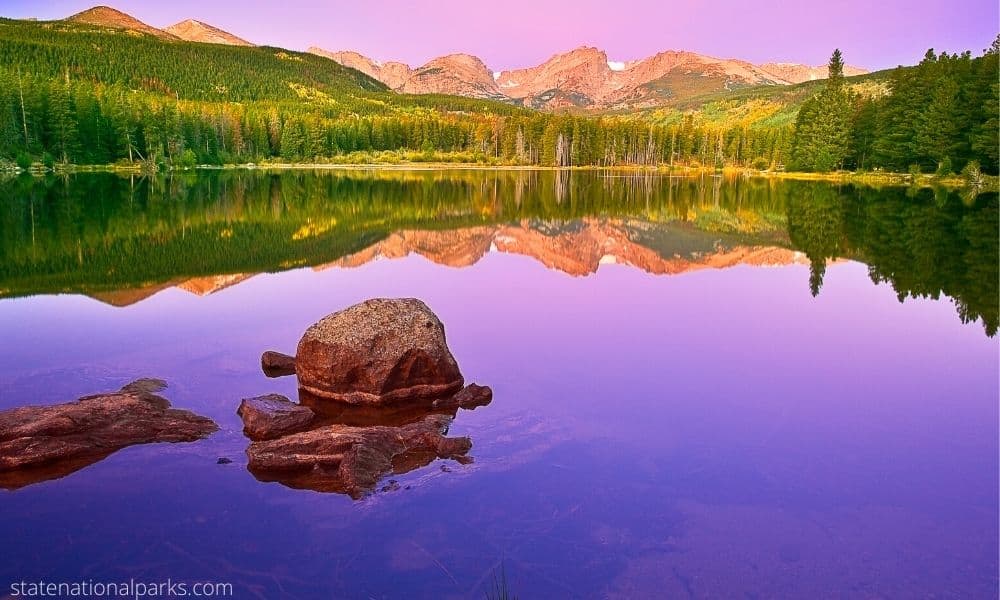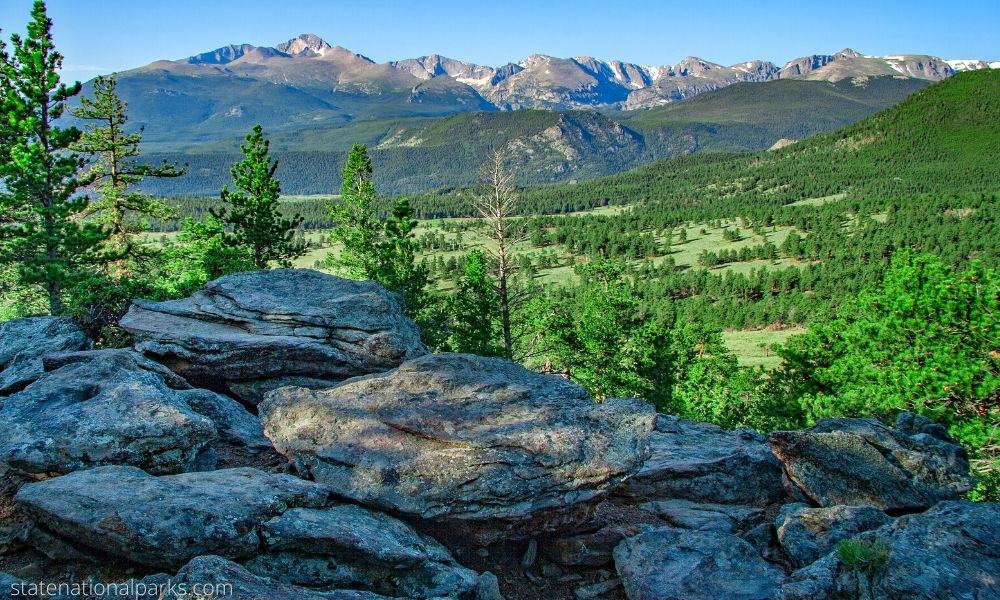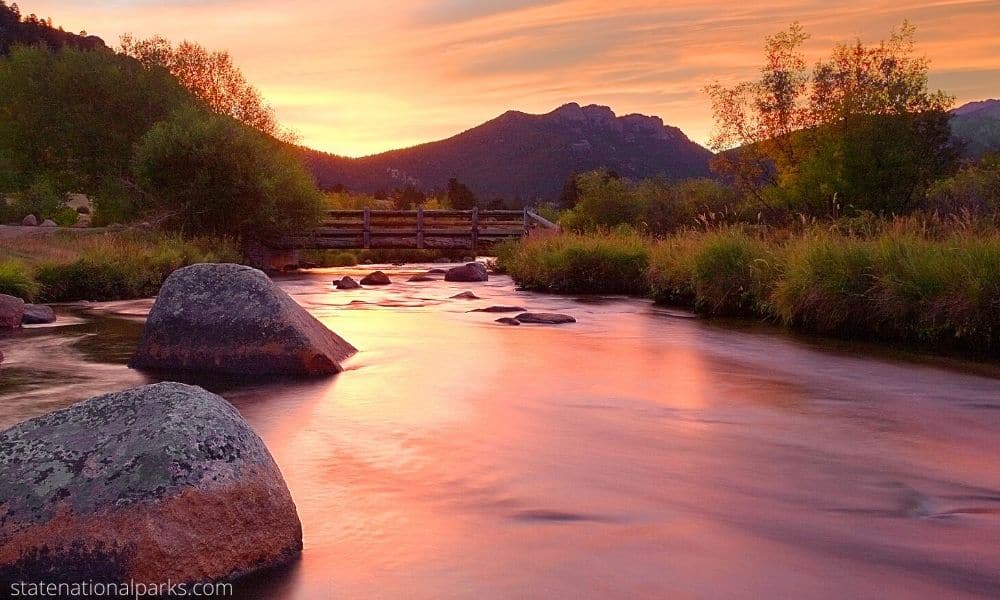 Rocky Mountain National Park is in northern Colorado and covers the Continental Divide. It is well known for the spectacular Trail Ridge Road and its Old Fall River Road, which passes through magnificent alpine meadows, ponderous forests and beautiful tundra. The longest and most scenic route, the Keyhole Trail, passes through high, majestic mountains. The Park’s longest drive, the Bear Lake Trail, offers panoramic views of the northwest ridge of the Rocky Mountains. The most popular trail, the South Fork Trail, follows the south side of the continental divide and meanders through beautiful meadows and forests.
Rocky Mountain National Park is in northern Colorado and covers the Continental Divide. It is well known for the spectacular Trail Ridge Road and its Old Fall River Road, which passes through magnificent alpine meadows, ponderous forests and beautiful tundra. The longest and most scenic route, the Keyhole Trail, passes through high, majestic mountains. The Park’s longest drive, the Bear Lake Trail, offers panoramic views of the northwest ridge of the Rocky Mountains. The most popular trail, the South Fork Trail, follows the south side of the continental divide and meanders through beautiful meadows and forests.
Rocky Mountain National Park’s twenty-three miles of hiking and biking trails are easy to maneuver. Hikers can enjoy the miles of rocky mountain vistas, dramatic cliffs, abundant wildflowers, and abundant wildlife. The Park features a few dozen routes, ranging from moderate to challenging. Hikers can find a variety of routes by using the Park map or online research. Many guided hikes are available, but most visitors prefer to follow the trailheads and access trails themselves.
Traveling by car is not permitted within the Park. Instead, you must take a road through the Park to the parking area. From there, you can walk the thirty-two miles of rocky road to the Park Visitor Center. Be sure to fill out the necessary permit forms and return to the parking area before your trip is over.
For some of the best scenery in Colorado, you should head to Rocky Mountain National Park’s East Rim Road. This road starts at the Creek Camp Visitors Center and proceeds through a wooded campground. Just off the road, you’ll see the first signs of Rocky Mountain National Park: ponderous old trees and wildflowers. Follow the road a few miles to a gazebo and camping area. There, you can park your car and enjoy a well-developed campground with fire rings, picnic tables, and grills.
Hiking is the best way to explore Rocky Mountain National Park. However, it isn’t for everyone. In order to hike safely, you need to know the best times to visit and the proper equipment. To get an accurate forecast, you should consult the Park map. You will also want to wear comfortable shoes, long pants, and layers so that you can stay cool and dry.
One of the greatest things about Rocky Mountain National Park is that it has a lot to offer visitors of all ages. Although you can’t do much at night, the Park offers many night activities such as hiking, biking, and horseback riding. As you drive through the Park, you’ll see evidence of ancient Indian cultures, such as the Bighorn Canyon and the Cliffs of Tensas. You’re sure to hear a few Native American tribes such as the Lakota and Cheyenne as you pass through. Whatever you’d like to do, you’re sure to find it at Rocky Mountain National Park.
Rocky Mountain National Park is known for its dramatic and unpredictable weather conditions. Here are some things to keep in mind when it comes to the weather at Rocky Mountain National Park:
- Seasons: The park experiences four distinct seasons, with winter typically lasting from November to April, spring from April to June, summer from June to September, and fall from September to November.
- Temperature: The temperature in the park can vary widely, even within the same day. In the summer, temperatures can range from the 70s to the 90s during the day, while in the winter, temperatures can drop well below freezing.
- Precipitation: The park receives a significant amount of precipitation, with snowfall in the winter and thunderstorms in the summer. It is important to be prepared for these conditions and to check the weather forecast before heading out on a hike or other outdoor activity.
- Altitude: The park is located at a high altitude, with elevations ranging from 7,500 to over 14,000 feet. At higher elevations, the air is thinner and temperatures can be colder, so it is important to acclimate properly and be prepared for changes in weather.
- Lightning: The park is known for its frequent lightning strikes, especially during the summer months. It is important to seek shelter in a safe location during thunderstorms and avoid exposed areas such as mountain peaks and ridges.
- Road closures: Due to snow and other weather conditions, some of the park’s roads may be closed during certain times of the year. It is important to check the park’s website for road conditions before visiting.
Overall, the weather in Rocky Mountain National Park can be unpredictable, so it is important to be prepared and check the forecast before heading out. Bring appropriate clothing and gear, and be prepared for changes in weather.
Related posts:
Rocky Mountain National Park is one of the most popular national parks in the United States, known for its stunning mountain vistas, alpine meadows, and diverse wildlife. While there are plenty of hiking trails to explore in the park, drivi...
Rocky Mountain National Park is one of the most popular and iconic national parks in the United States. The park is known for its stunning landscapes, alpine lakes, and abundant wildlife. But behind the beauty lies a rich history that...
Rocky Mountain National Park is a stunning destination that offers a plethora of outdoor activities and breathtaking views of the Colorado Rockies. With over 355 miles of hiking trails, 150 lakes, and numerous wildlife sightings, this nat...
When it comes to Rocky Mountain National Park camping, one of the most important things to do is pack correctly for your upcoming trip. You can learn a lot of great camping tips and recipes from books on how to be more comfortable while camping, but ...
Rocky Mountain National Park is a protected area located in the Front Range of the Rocky Mountains, situated in the north-central region of the state of Colorado in the United States. It was established on January 26, 1915, and covers an ar...